The Dragon Island of Mallorca is actually called Sa Dragonera. Is it named that way because it resembles a sleeping dragon in the sea? That would be a great tale, but unfortunately it’s not true. The name is rather attributed to relatives of dinosaurs. They still inhabit the protected island today, making the excursion to Dragon Island (or Dinosaur Island, if you like) an unforgettable experience for young explorers.
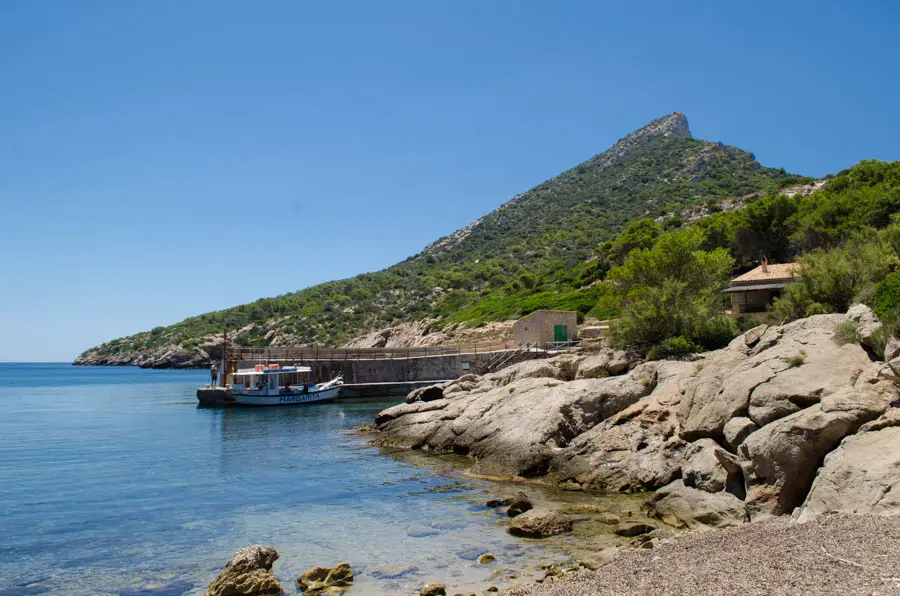
Transparency note: Some links in this post may lead to external booking opportunities. If a purchase is made, we receive a small commission. The price does not change for you.
Dragón means dragon in Spanish. It’s no wonder, then, that almost everyone claims that Dragonera is named so because the uninhabited island resembles the back of a dragon. But that is actually not what it refers to. In Catalan, lizards and geckos are also called dragó or dragonets. And that brings us a little closer to the truth. Because curious and cheeky lizards are abundant on Sa Dragonera in the southwest of Mallorca. Whether you’re just taking a short exploration tour, stopping for a swim at the small beach, or embarking on a longer hike on Sa Dragonera, you can’t avoid encountering these little namesakes.
By Boat: Tour from Santa Ponça & Peguera
The History of the Dragon Island of Mallorca: Pirates & Smugglers
It is said that the name of the island’s harbor, Es Lledó, is derived from the word thief. And that’s not too far-fetched, as the small island with a freshwater spring in the so-called Moor’s Cave was not only used as a refuge by prehistoric humans but also by thieves, criminals, pirates, and smugglers.
The most famous guest was Barbarossa, the feared leader of the corsairs and the most powerful pirate in the Mediterranean in the first half of the 16th century. He hid with his fleet on Dragonera, among other places, to attack merchant ships that crossed his path on their way to the mainland.
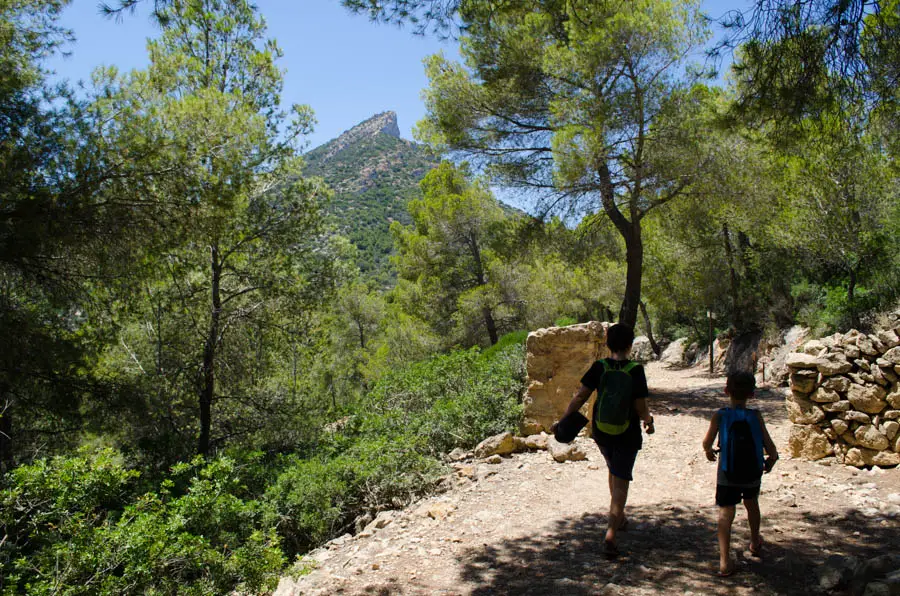
Smuggling continued on Mallorca well into the 20th century. Tobacco, in particular, was smuggled from hidden spots on the offshore islands to the Mallorcan coast under the cover of darkness. From there, the smugglers transported the goods along remote footpaths. Many of these former secret paths are now challenging hiking trails.
Traces of the first human settlements on Sa Dragonera date back to the Stone Age. A Roman burial site near the harbor provides further evidence of Roman presence.
Like hiking? Find easy hiking trails on Mallorca.
The Sa Dragonera Nature Park
The Sa Dragonera Nature Park includes not only the Dragon Island (let’s continue calling it that), but also encompasses protected areas of both land and sea. The islands of Pantaleu and Sa Mitjana, located off the coast of Sant Elm, are also part of this protected area. The marine portion of the protected area is particularly ecologically valuable and serves as an important habitat for many animals and plants.
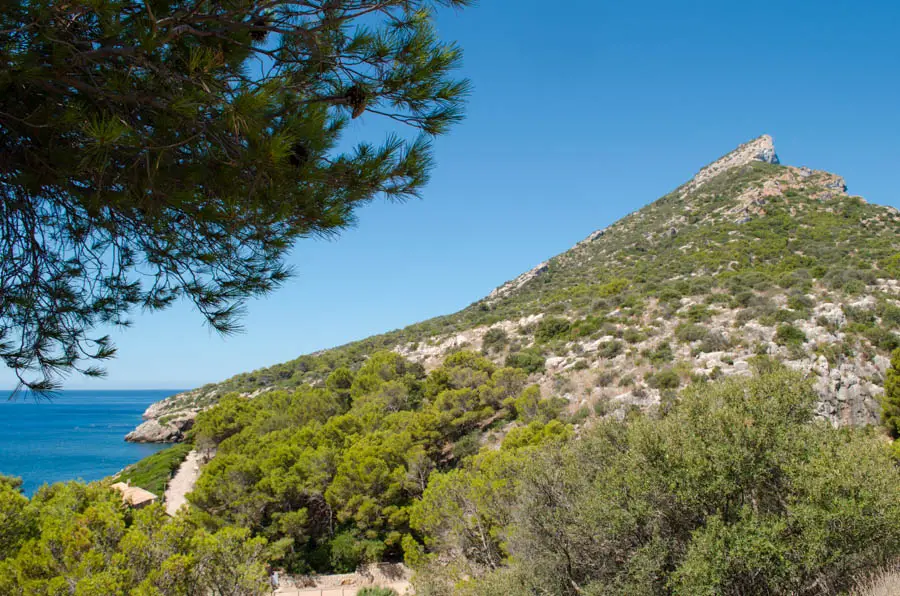
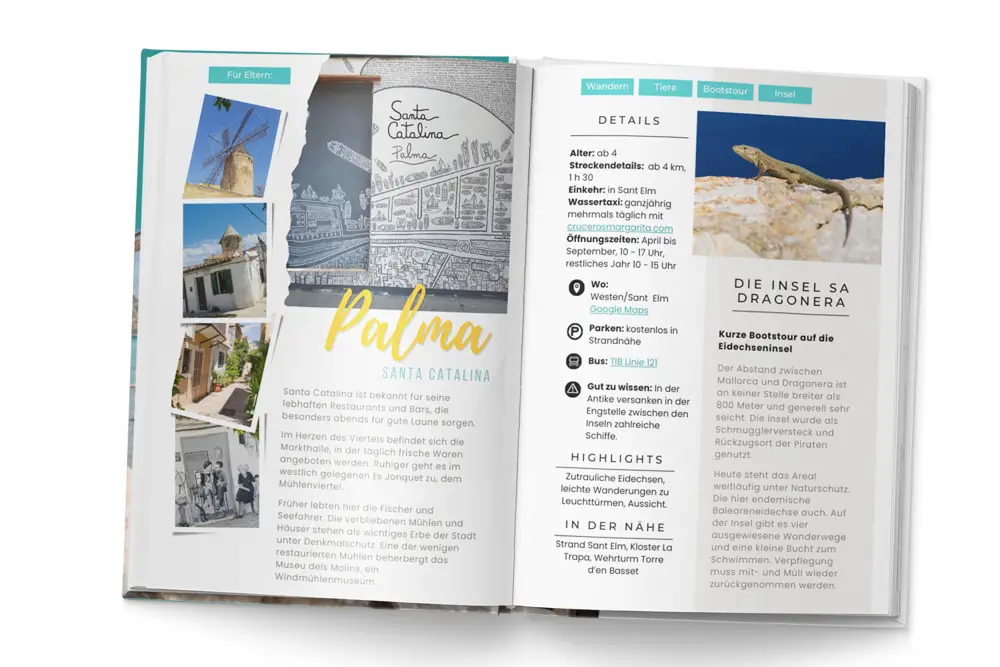
Du liebst diese Tipps?
Entdecke alle kinderfreundlichen Aktivitäten, Strände und exklusive Rabatte in meinem Mallorca-Guide.
The distance between Mallorca and Dragonera is never wider than 800 meters and generally very shallow, but it is not advisable to swim across. The currents are treacherous. Even in ancient times, numerous ships sank in the narrow passage between the islands. The underwater world surrounding the island resembles a jungle with extensive seagrass meadows and impressive rock formations, making it a paradise for snorkeling in Mallorca.
Geologically, the island is a continuation of the Tramuntana Mountains, only interrupted by the narrow waterway. The cliffs are limestone, exhibiting the typical characteristics of karst formations. Sa Dragonera is four kilometers long and one kilometer wide at its widest point.
Museum & Information Point
After docking at the port of Dragonera, you will be greeted by one of the park rangers. There will be a brief introduction to the island’s rules and an overview of the available routes. If you have any questions, you can approach the staff directly. The only restroom facility is located here at the beginning.

Adjacent to the harbor, you will find the information center, which houses a small museum. Inside, you can witness the evolution of the lizards that dominate Sa Dragonera, as they are direct descendants of dinosaurs. You will have the opportunity to observe them up close during your stay on the island.
The museum also features a replica of a Mediterranean monk seal. Encountering one in real life is rather unlikely, as they are practically extinct in the Mediterranean, with only a few remaining individuals in Greece. However, biologists hold hope that they may eventually repopulate areas such as Mallorca. If you require further information about excursions on the island, this is the place to inquire with the park rangers. Next to the museum, in an old stable, you will find the island’s only restroom facility.
The Paris Meridian
The Paris Meridian, also known as the Line of Aragon, was the former prime meridian calculated by the Frenchman François Arago in Mallorca. It can be crossed during one of the tours on the island.
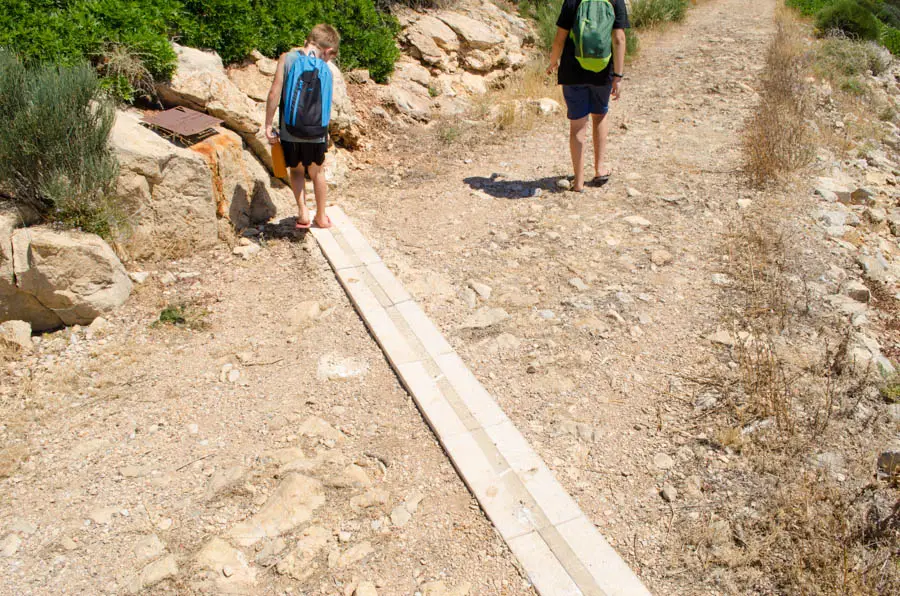
During the Napoleonic Wars, Aragó was exposed as a spy and imprisoned. However, he managed to escape from the island in a boat. Despite his efforts in calculating the meridian, it did not yield significant results. Just a few years later, the Greenwich Meridian replaced the Paris Meridian and remains the official prime meridian to this day.
Dragons, Lizards & other Animals
The Dragon Island of Mallorca serves as a secure habitat for many endangered animal species. Eleonora’s falcons and Audouin’s gulls breed on the cliffs. However, the true stars of the island are other creatures.
The greenish-colored lizard, known as sargantana in Catalan, reigns supreme on Dragonera. It resides in crevices and rock fissures and differs from the Pitiusan lizards found on the smaller islands around Mallorca.
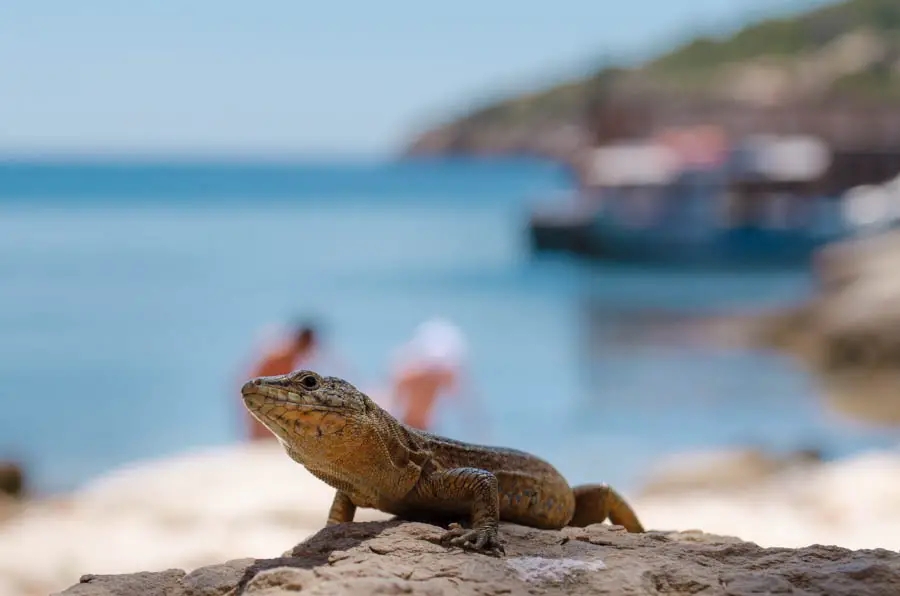
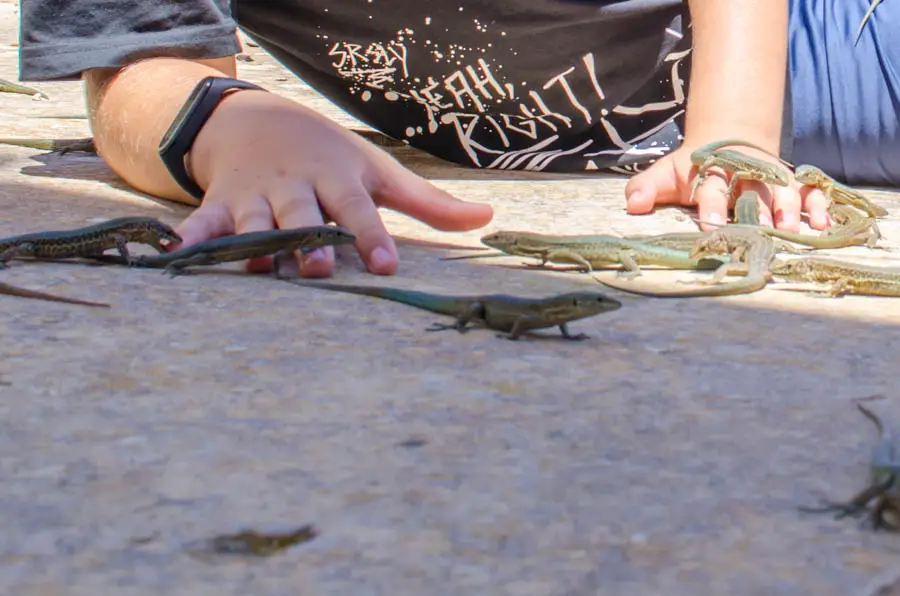
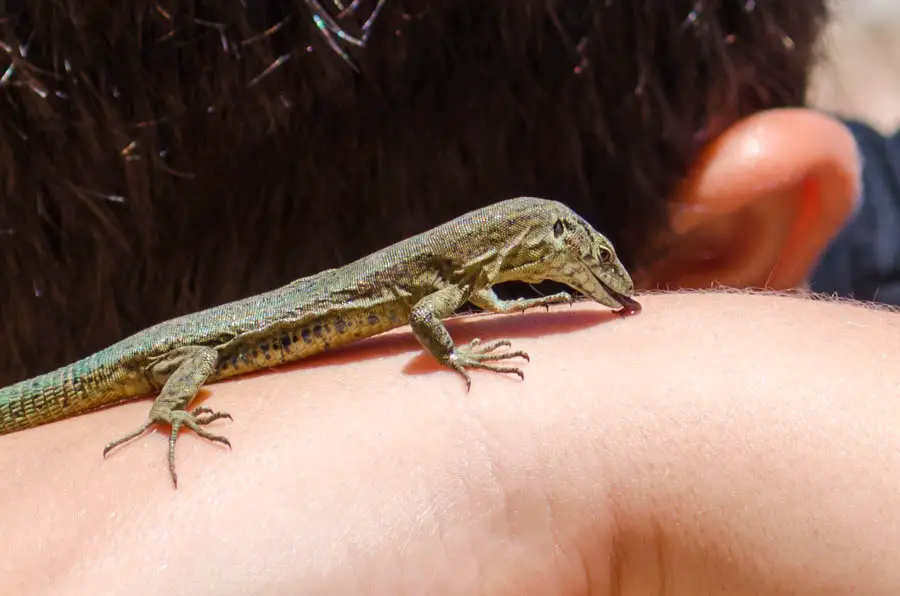
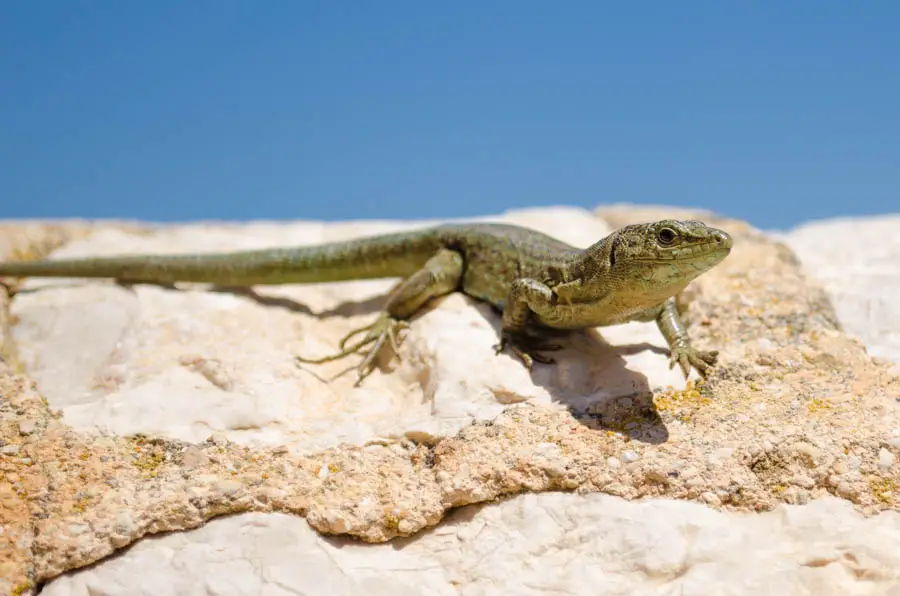
The Balearic lizard is an omnivorous species, feeding on fruits and invertebrates. Despite its dominant population on the island, it faces several natural predators, including falcons and gulls. Like other lizards, it has the ability to shed its tail as a defense mechanism, which continues to twitch and distract predators while the lizard finds a safe hiding spot.
Another crucial animal for the island is the Mediterranean monk seal, known as Vell Mari here. When you enter the port of Sa Dragonera, you may catch sight of the small cave that bears its name. These seals used to inhabit the coves and beaches of Mallorca but have been pushed into more secluded areas, preferably caves with underwater access, due to human presence.
Currently, they are one of the most endangered species on Earth. The few remaining individuals can only be found in Greece, Morocco, or Mauritania. However, there are conservation projects aiming to prevent their extinction and reintroduce the species to selected natural habitats. You can find a replica of such a seal in the small museum at the harbor.
Hiking on Sa Dragonera
In the Sa Dragonera Nature Park, there are several hiking options available for visitors. There are four marked routes, ranging from very easy to challenging. It is important to stay on the designated paths and always allow ample time for the return journey to ensure you don’t miss the last boat back to Sant Elm. If you are part of a hiking group with more than ten people, you will need to obtain written permission in advance, which must be requested beforehand.
The Na Miranda Viewpoint
The na Miranda viewpoint trail is the shortest of the four routes. It covers a distance of 1.2 kilometers from the harbor, passing through an agricultural area, and leads to na Miranda, an old cistern that offers spectacular views towards Mallorca. Along the way, you will also come across Es Colomer, an old tower, as well as a pleasant picnic area with benches and tables. The entire round trip can be completed in approximately 30 minutes.
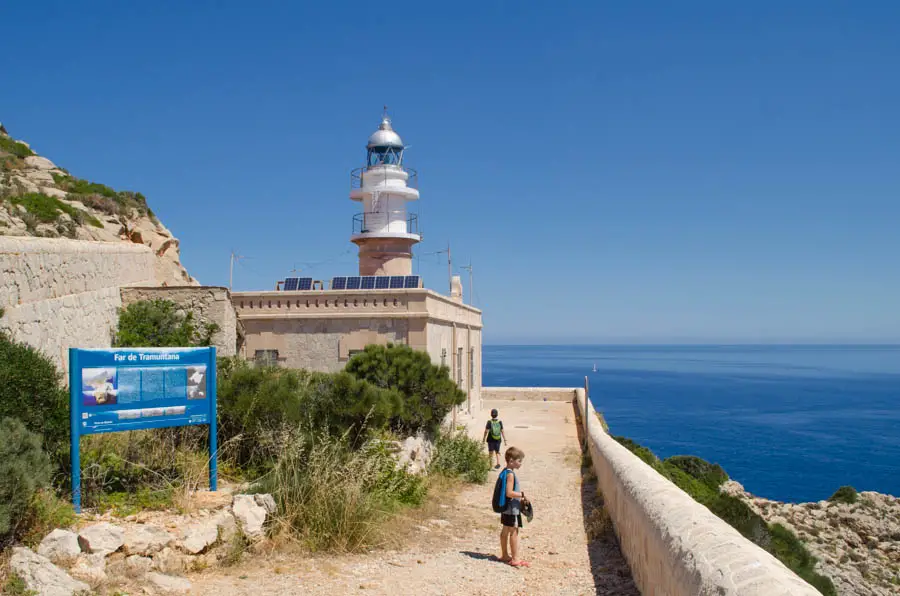
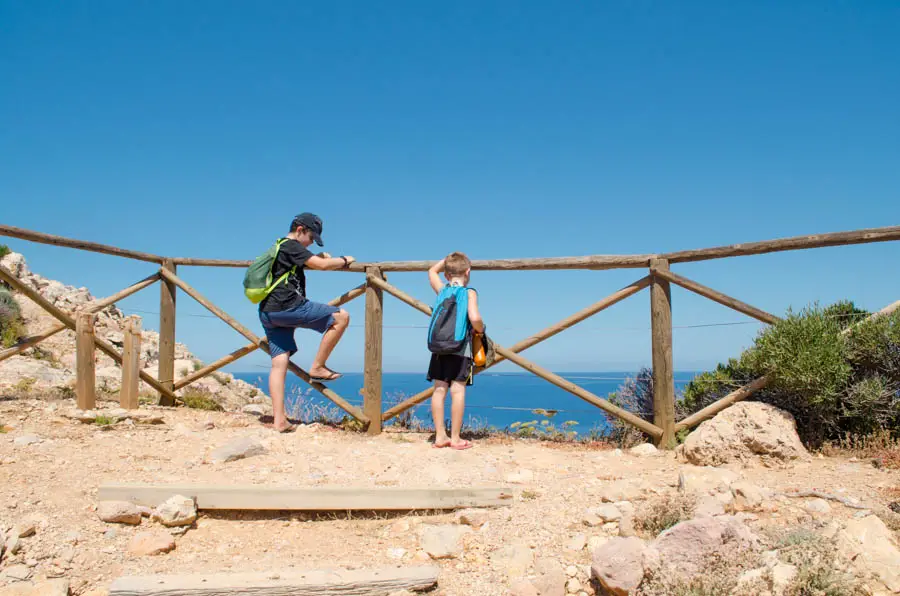
This route is perfect for those who prefer a shorter walk but still want to enjoy the nature and the sea around Sa Dragonera. There is minimal incline on this tour. The starting and ending point is the bay of Cala Lladó at the harbor, where you can finish off with a refreshing swim.
To the Far de Tramuntana Lighthouse
The one-way distance from the harbor to the lighthouse at the eastern end of the island is 1.7 kilometers. The round trip, without major breaks, can be completed in 60 minutes. From the plateau in front of the lighthouse, you will have a great view of the abandoned Trappist monastery La Trapa, as well as the watchtower and the bay of Torre de Cala en Basset.
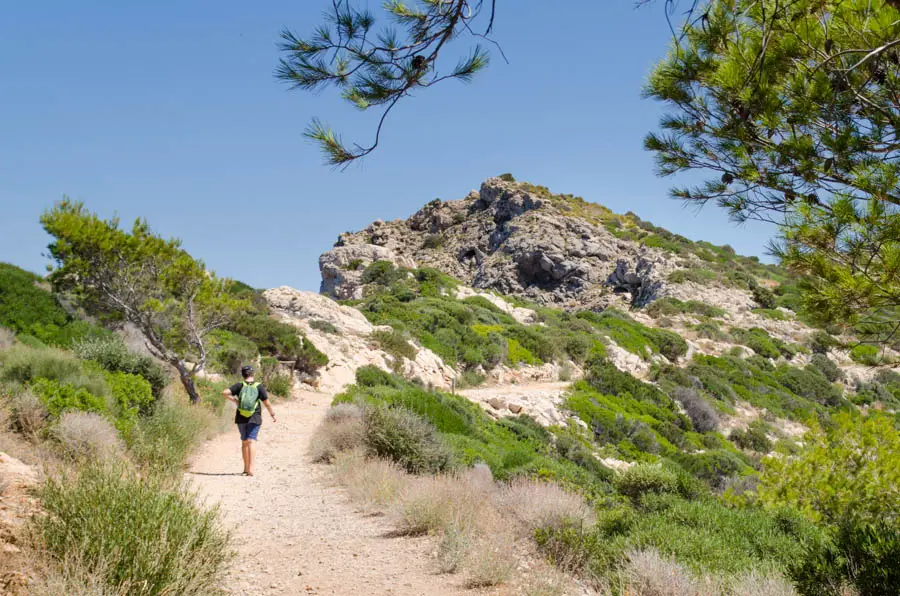
For children, the invasion of the lizards is particularly exciting. At the lighthouse, you can settle down for a picnic. Thanks to the breeze coming from the sea, it is pleasant to stay in the shade of the tower, even in the summer. The dragonets, in search of something edible, inspect all visitors and sometimes even crawl into backpacks.
A small request: According to the rules of the nature reserve, the lizards should not be touched. It is almost impossible since they are the ones seeking contact. However, refrain from feeding them. It is never advisable to interfere in such closed ecosystems. The lizards have survived on Sa Dragonera for many years without our offerings, and will continue to do so as long as we behave accordingly.
Inside the Far de Tramuntana lighthouse, there is an exhibition on the lighthouses of Dragonera. The key to access it can be obtained at the information center in the harbor.
This hike is perfect for families with young children. The distance is manageable, and the incline is moderate. However, there is little shade along the way. Therefore, it is essential to remember to bring head protection and take frequent breaks at the few shady spots, especially during summer.
To the na Popia Lighthouse
The most challenging yet fascinating hike takes you from the harbor to the old na Popia lighthouse. It covers a distance of over 8 kilometers (round trip) and involves a climb of 361 meters to the highest point of the island. The trail is well-maintained with a moderate incline but lacks shade. Plan for approximately three hours for this route without breaks.
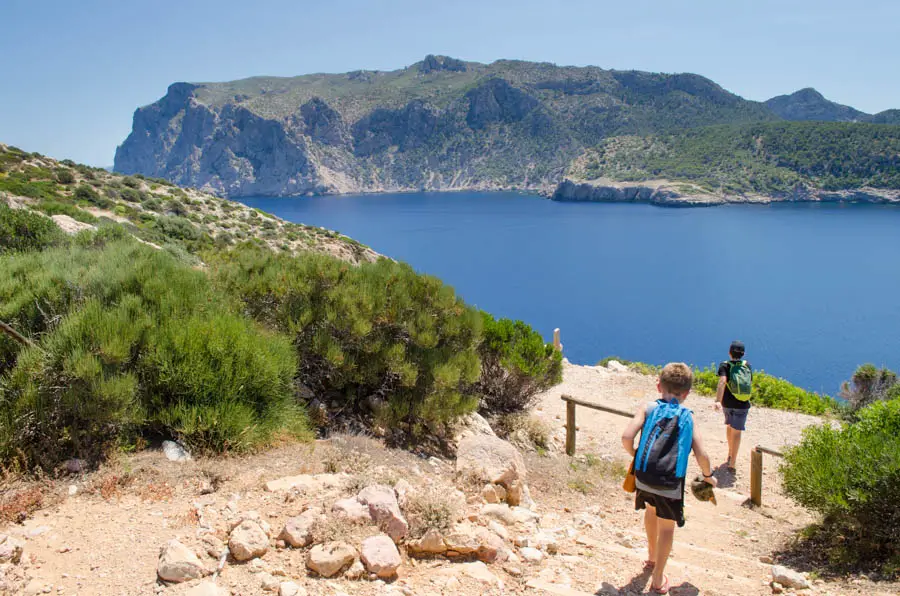
The neoclassical-style na Popia lighthouse was constructed in the mid-19th century. It was inhabited by two lighthouse keeper families and served the purpose of guiding ships while impressing with its elegance and grandeur.
The construction of the pathway alone took three months. The lighthouse itself was built by prisoners. The light emitted from the tower could be seen for over 50 nautical miles (approximately 80 kilometers). However, due to frequent foggy conditions, its effectiveness was limited. Therefore, in 1910, it was replaced by the two other lighthouses that were situated at lower elevations.
To the Far de Llebeig Lighthouse
You can reach the lighthouse at the westernmost tip of Dragonera via a well-maintained trail that covers 4.5 kilometers and leads to the Far de Llebeig. This route also involves some ascent, and it will take you slightly under three hours for the round trip without major breaks. Along the way, you will come across the eponymous 16th-century watchtower, which was restored in 2004 and is open to visitors.
This hike is manageable with children; however, they should have some enthusiasm for walking. The distance is a bit longer, and there is limited shade along the trail. The panoramic view at the lighthouse at the end of the route is truly spectacular.
Swimming on Sa Dragonera
There are no beaches on the Sa Dragonera, that can compare to those found on Mallorca. Therefore, if your main focus is solely on beach trips, Dragonera might not be the ideal destination. The excursion to the neighboring island is more about the combination of nature, lizards, and a boat ride, with a small bathing break at the end.
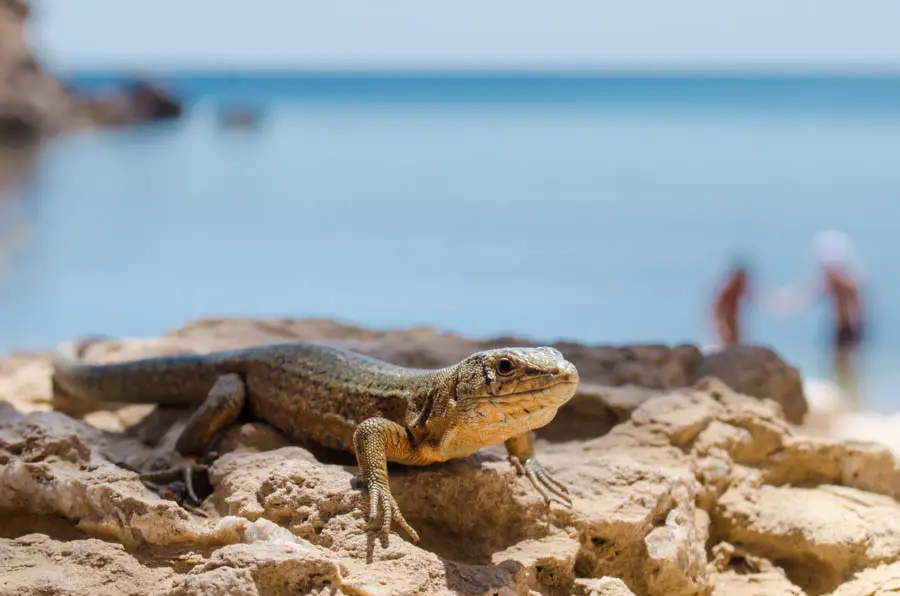
There is only one designated area on Sa Dragonera where swimming is allowed, and that is next to the harbor. As mentioned before, the island is a nature reserve, and it is important to stay on the official paths and not venture off to swim.
The bay in the harbor is picturesque but small and rocky. It is suitable for refreshing and taking a break. It might be a good idea to bring water shoes, especially if your children have sensitive feet, as sea urchins are not uncommon in the area.
Before packing your swimwear back into your backpack, make sure no cheeky lizards have found their way into it. They are truly everywhere and seize every opportunity to search for food.
Boat Trips to Sa Dragonera
There are several options to reach the Dragon Island from Mallorca. Here are the most exciting and practical ways.
By boat from Peguera and Santa Ponça
Even if you are not able to drive to Sant Elm and take a water taxi from there, there is still a way for you to reach the island. Boat excursions are available from Peguera, Camp de Mar, and Santa Ponça, offering several hours of stay on Mallorca’s Dragon Island.
By Kayak from Sant Elm
If you prefer not to use a boat but want a more adventurous option, you can kayak from Sant Elm to Dragonera. These guided trips are not very long and are relatively easy, suitable for children to participate in paddling.
Snorkeling trip from Sant Elm
For a unique sightseeing experience, you can explore the Sa Dragonera nature reserve underwater instead of setting foot on land. This snorkeling trip is suitable for children aged 8 and above with good swimming skills.
In Short
Getting there: From Sant Elm, there are multiple daily trips to Dragonera throughout the year with crucerosmargarita.com. From Santa Ponça, there is a high-speed boat service during the summer.
Parking: In Sant Elm, there are public parking lots near the beach, located here and here. From there, it’s just a short walk to the harbor, where Cruceros Margarita departs for Dragonera.
Opening hours: April to September, 10 am to 5 pm; the rest of the year, 10 am to 3 pm.
Price: Admission to Sa Dragonera costs 1 euro, usually collected on the boat. The water taxi costs 12 euros.
What to take: There are no food options on the island, so be sure to bring enough water, snacks, and sun protection.
Strollers: Not suitable, as the island is not accessible for strollers or wheelchairs.
Website: www.conselldemallorca.cat/dragonera
Read more
Want more recommendations like this? Check out more than 100 day trips and excursions on Mallorca.
Planning your holiday on Mallorca:
Book your Flight here
Great Rental Car Offers